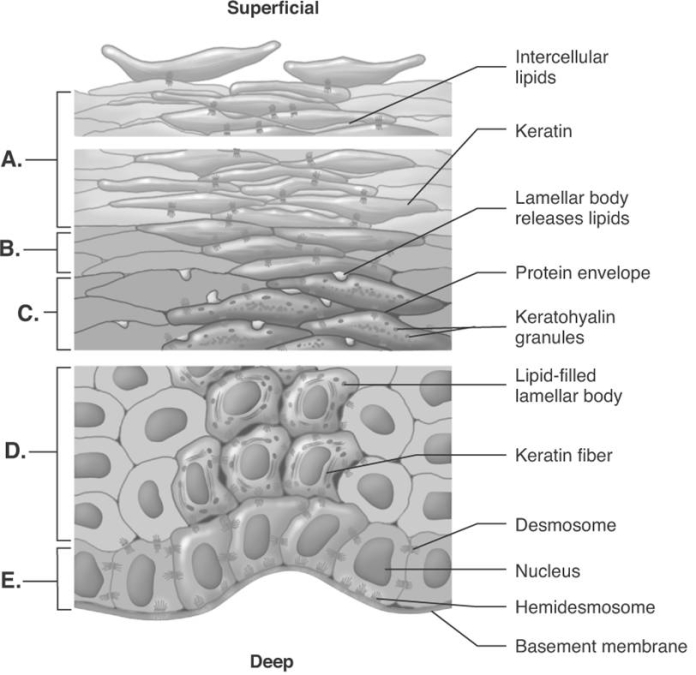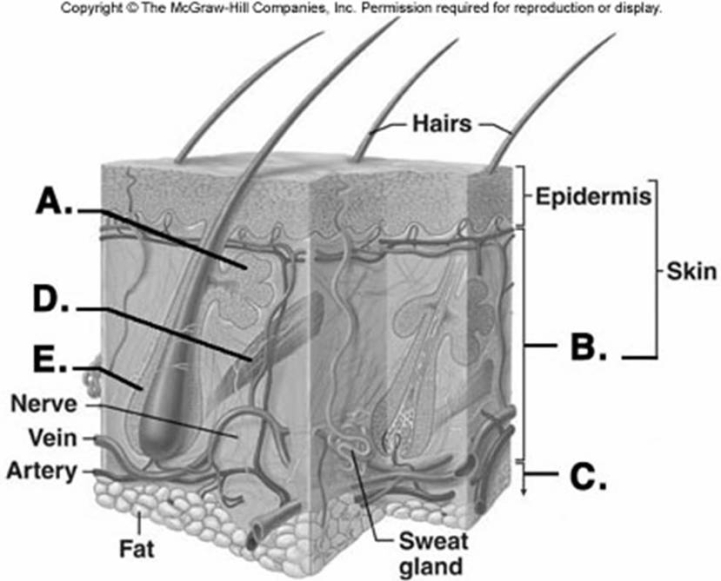A) dermal striae.
B) cleavage lines.
C) reticular lines.
D) melanocytes.
E) dermal papillae.
Correct Answer

verified
Correct Answer
verified
Multiple Choice
Which of the following will help cool the body?
A) absorption of ultraviolet light rays by the skin
B) evaporation of sweat from the skin's surface
C) contraction of the arrector pili muscles
D) decreased blood flow to the skin
E) absorption of excess sweat
Correct Answer

verified
Correct Answer
verified
Multiple Choice
 -The figure illustrates keratinization in the epidermis. What layer of the epidermis is "E"?
-The figure illustrates keratinization in the epidermis. What layer of the epidermis is "E"?
A) stratum spinosum
B) stratum corneum
C) stratum basale
D) stratum lucidum
E) stratum granulosum
Correct Answer

verified
Correct Answer
verified
Multiple Choice
The proximal portion of the nail is the
A) nail root.
B) nail body.
C) nail fold.
D) eponychium.
E) hyponychium.
Correct Answer

verified
Correct Answer
verified
Multiple Choice
The activity of apocrine sweat glands
A) produces cerumen.
B) leads to body odor.
C) gives the skin a healthy glow.
D) produces sweat on the palm of the hand.
E) produces an oily secretion.
Correct Answer

verified
Correct Answer
verified
Multiple Choice
Melanin
A) is transferred to other cells by osmosis.
B) is increased with exposure to infrared light.
C) is absent in individuals known as albinos.
D) is a pigment produced by cells in the stratum corneum.
E) makes the skin lighter.
Correct Answer

verified
Correct Answer
verified
Multiple Choice
Which of the following skin changes is usually associated with aging?
A) Skin becomes thicker.
B) There is an increase in the number of elastic fibers in the skin.
C) Loss of subcutaneous tissue contributes to sagging of the skin.
D) Localized increase in sebaceous glands leads to dry skin.
E) The amount of collagen in the dermis increases.
Correct Answer

verified
Correct Answer
verified
Multiple Choice
The amount of body area involved with a burn is determined by the
A) color of the skin.
B) amount of pain.
C) rule of nines.
D) cause of the burn.
E) ABCDE rule.
Correct Answer

verified
Correct Answer
verified
Multiple Choice
When comparing the dermis with the hypodermis, the dermis
A) has more fat cells than the hypodermis.
B) is a more vascular tissue than the hypodermis.
C) is divided into two layers; the hypodermis is not.
D) contains melanocytes; the hypodermis does not.
E) and the hypodermis do not contain collagen.
Correct Answer

verified
Correct Answer
verified
Multiple Choice
An abrasion of the skin results in which of the following?
A) fluid retention by the kidney
B) increased melanin production
C) portal of entry for microorganisms
D) loss of cell regeneration ability
E) irreversible damage to the epidermis
Correct Answer

verified
Correct Answer
verified
Multiple Choice
Due to the contraction of smooth muscle in the walls of the dermal blood vessels,
A) the blood vessels become dilated.
B) body heat is conserved.
C) more blood enters into the heart.
D) body temperature tends to drop in that area.
E) more blood flows to the skin.
Correct Answer

verified
Correct Answer
verified
Multiple Choice
 -What does structure "B" represent on the diagram?
-What does structure "B" represent on the diagram?
A) hair follicle
B) arrector pili
C) dermis
D) hypodermis
E) sebaceous gland
Correct Answer

verified
Correct Answer
verified
Multiple Choice
Which of the following hair colors is the result of a decrease in melanin?
A) black
B) brown
C) red
D) white
E) auburn
Correct Answer

verified
Correct Answer
verified
Multiple Choice
Impetigo is caused by the bacterium
A) Propionibacterium.
B) Staphylococcus.
C) Streptococcus.
D) Herpes.
E) Luteus.
Correct Answer

verified
Correct Answer
verified
Multiple Choice
 -The figure illustrates keratinization in the epidermis. What layer of the epidermis is "D"?
-The figure illustrates keratinization in the epidermis. What layer of the epidermis is "D"?
A) stratum spinosum
B) stratum corneum
C) stratum basale
D) stratum lucidum
E) stratum granulosum
Correct Answer

verified
Correct Answer
verified
Multiple Choice
Which of the following is NOT a type of burn?
A) primary burn
B) partial-thickness burn
C) second-degree burn
D) third-degree burn
E) full-thickness burn
Correct Answer

verified
Correct Answer
verified
Multiple Choice
Which layer of the epidermis is found in only a few areas of the body?
A) stratum basale
B) stratum spinosum
C) stratum granulosum
D) stratum lucidum
E) stratum corneum
Correct Answer

verified
Correct Answer
verified
Multiple Choice
The sloughing off of older cells from the surface of the skin is called
A) pollination.
B) keratinization.
C) melaninization.
D) germination.
E) desquamation.
Correct Answer

verified
Correct Answer
verified
Multiple Choice
The epidermis
A) is thicker than the dermis.
B) contains no blood vessels.
C) is composed of loose connective tissue.
D) is made up mostly of melanocytes.
E) is composed of the reticular and papillary layers.
Correct Answer

verified
Correct Answer
verified
Showing 121 - 139 of 139
Related Exams